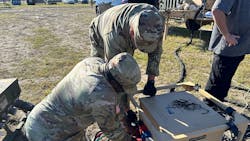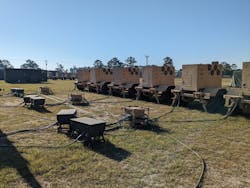U.S. Army Testing Microgrid System to Power Field Hospitals
In March, the U.S. Army Medical Test and Evaluation Activity (USAMTEAC) will conduct the second test of a microgrid system designed to power a field hospital.
Field hospitals are temporary hospitals or mobile modular medical units deployed to provide medical care to injured troops before they are transported to permanent medical facilities. The facilities can vary in size and typically include power-dense equipment like CT machines.
The Army currently uses 100-kW generators to power its field hospitals, but many of the units in inventory are reaching the end of their life cycle and need to be replaced.
In line with its goal of reducing net greenhouse gas emissions by 50% by 2030, the Army is testing a lower emissions microgrid system called the Advanced Medium Power Source (AMMPS). The goal is to see if it’s capable of replacing the 100-kW generators.
The AMMPS is a 120-kW microgrid system that includes two connected 60-kW generators. Rather than idling when not in use, the microgrid’s generators can be shut down if power demand drops, saving on fuel costs and reducing overall emissions.
The system is scalable and up to three AMMPS systems can be tied together to provide resilience and meet a field hospital’s peak power demands.
First test a rousing success
AMMPS successfully passed its first test, which was conducted last November by USAMTEAC, the 14th Field Hospital, and several other Army units during a field training exercise at Fort Stewart, Georgia.
Soldiers from the 14th Field Hospital successfully deployed and operated the AMMPS system to power a 56-bed field hospital for the duration of the exercise. The Army reported use of the microgrid led to a 60% reduction in fuel consumption compared to the traditional 100-kW generators, and it improved power reliability.
The test also proved that maintenance can be performed on the generators while the microgrid is operational, without disrupting power to the field hospital.
“It’s critical to test and evaluate the microgrid system in multiple ways – through environmental testing, active-duty user touchpoints, real-world scenarios and realistic operational scenarios to be sure they are reliable,” said Benjamin Pryor, medium power product manager with the Army’s Project Management Office, Expeditionary Energy and Sustainment Systems.
“These systems need to work on the battlefield to fully power our field hospitals to ensure the best medical care for our soldiers … as quickly as possible and save lives,” Pryor added.
Second test will be with a larger field hospital
During the second test in March, AMMPS will be called on to power a 92-bed field hospital for the 528th Field Hospital at Fort Liberty, North Carolina.
The U.S. military has made significant commitments to integrate microgrid technology in their operations. In 2022, the Army announced it would build a microgrid at each of its bases worldwide by 2035. The Navy and Marine Corps also made similar commitments that year.
White paper: Streamlining Microgrids for Cost-Efficiency
Early bird registration saves money at Microgrid 2024 in Baltimore
Register now to experience the Revolution in Energy
As demonstrated by the field hospital microgrid, it appears the Army is using a broad definition of "bases" and is looking for microgrids to provide reliable power and reduce diesel fuel consumption even at its temporary bases.
The U.S. Army Corps of Engineers recently commissioned a long-duration energy storage (LDES) microgrid. The project, which is at the Contingency Basing Integration Training Evaluation Center (CBITEC) at Fort Leonard Wood, Missouri, will demonstrate how LDES microgrids can reduce diesel fuel consumption and provide energy resilience at forward operating bases, remote installations and temporary bases erected to provide disaster relief.
About the Author
Kathy Hitchens
Special Projects Editor
I work as a writer and special projects editor for Microgrid Knowledge. I have over 30 years of writing experience, working with a variety of companies in the renewable energy, electric vehicle and utility sector, as well as those in the entertainment, education, and financial industries. I have a BFA in Media Arts from the University of Arizona and a MBA from the University of Denver.


